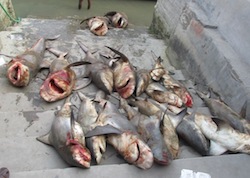SEJournal Online is the digital news magazine of the Society of Environmental Journalists. Learn more about SEJournal Online, including submission, subscription and advertising information.
TipSheet: Shark Week Media Frenzy a Chance to Actually Cover Sharks
It’s high summer, and real news is usually on vacation, so traditionally in late July, Discovery Channel’s Shark Week whips up a media frenzy boosted by an edge of fear. The media waters boil with imagined blood. Ratings soar.
But the reality is people kill far more sharks than sharks kill people. So for environmental journalists, Shark Week is a chance to tell many stories about shark conservation — and to tell about real sharks as they exist, rather than in their role as movie monsters.
Technically, on Discovery, Shark Week runs from July 23 to July 30. But on beaches around the country, throngs of swimmers will shiver and thrill for the rest of the summer as they wade into the waves. Inevitably, given the number of bodies in the August surf, some shark will try to bite one of them, and news bulletins will flash. Follow it on cable.
But shark attacks on people are rare, according to the International Shark Attack File. You are much more likely to die from lightning or a tornado. In fact, you are more likely to die from sand hole collapses or a toilet.
Moreover, only a few of the more than 400 species are dangerous to humans (white, tiger and bull sharks). And in 2016, there were just 56 unprovoked shark attacks in the United States, with no fatalities.
 |
| White cheek sharks slaughtered for the illegal shark fin trade. Photo: Interpol |
On the other hand, humans kill roughly 100 million sharks each year. Maybe more. This is much more than most species can endure if their populations are to be sustained.
A major fraction of that total comes from the practice of shark finning — where fishermen catch sharks, cut off their fins and toss them back into the sea to die. The fins are sold for shark-fin soup, which fetches huge prices in some Asian countries, and even in the United States.
Shark finning is illegal in U.S. waters. But selling shark fins, or shark fin soup, is not illegal in most states. Worldwide, the legal situation is even worse for sharks. You can see a nation-by-nation breakdown here.
Shark fishing may remain legal even where shark finning is banned. There is no strict or comprehensive worldwide treaty protecting sharks from finning, although some weak restrictions protect a few species. Protection for sharks under CITES (the Convention on International Trade in Endangered Species) is limited.
The U.S. federal laws on shark finning are the Shark Finning Prohibition Act of 2000 and the Shark Conservation Act of 2010.
Bills banning possession and sale of shark fins in the U.S. (HR 1456, S 793) have been introduced in the current Congress, but have not gone far.
Selling shark fins is currently illegal in 11 U.S. states. They include California, New York, Washington, Rhode Island, Texas, Delaware, Illinois, Massachusetts, Maryland, Oregon, and Hawaii, as well as the Pacific territories of Guam, American Samoa and the Commonwealth of the Northern Mariana Islands.
What laws protect sharks in your state? How do sharks and their relatives (skates, rays and sawfish) fit into your regional waters and estuaries?
There was news recently in Maryland when the legislature passed, and the governor signed, a bill putting a moratorium on fishing contests for cownose rays in the Chesapeake Bay. Watermen there have blamed the rays for depleting commercial seafood species.
Is shark tourism (“swim with the sharks,” cage diving) an industry in your area? Does it involve feeding the sharks? Some conservation groups support shark tourism.
Apart from finning, there is also a shark fishery in many places. Debate rages over whether this is a good thing or a bad thing. Find out how state and federal regulations affect the shark fishery in your area. There is a good overview of the situation from NOAA here.
You can find out more about sharks and shark conservation from groups like Shark Advocates International, Oceana, Project Aware, the Shark Trust or Shark Savers.
Other good sources include the Mote Marine Lab, the Florida Museum of Natural History, the Bimini Biological Field Station, NOAA Fisheries and scientists on a list compiled by Scientific American.
* From the weekly news magazine SEJournal Online, Vol. 2, No. 29. Content from each new issue of SEJournal Online is available to the public via the SEJournal Online main page. Subscribe to the e-newsletter here. And see past issues of the SEJournal archived here.

















